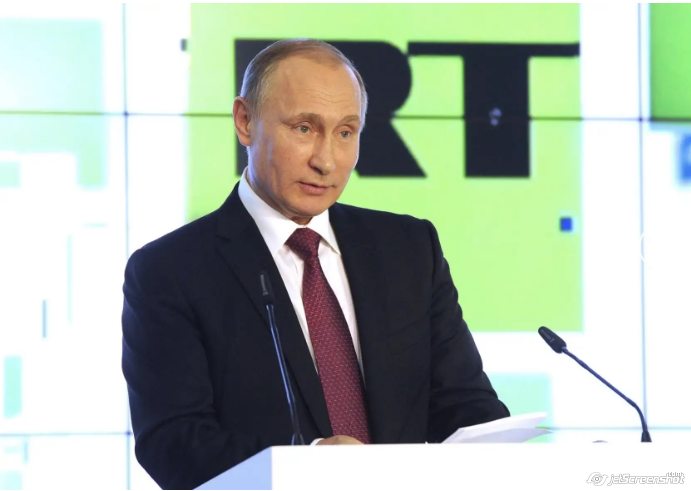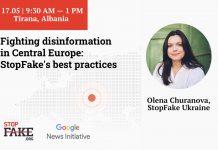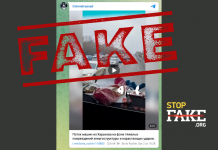By Esteban Ponce de León, for @DFRLab
Este artículo también está disponible en Español.
A analysis of Spanish-language media articles about the war in Ukraine over the course of eight months revealed that Spanish speakers continue to be exposed to Russian propaganda and misleading information on social media.
Pro-Kremlin narratives that have spread through Spanish-language countries typically amplify justifications for Russia’s invasion of Ukraine or promote anti-US sentiments. These narratives are not just pushed by Russian outlets, as China also amplifies messaging echoing that of the Russian state.
On March 1, 2022, YouTube suspended access to Kremlin-linked channels in Europe, and later expanded the suspension to other regions, including Latin America. Soon after, other major social media platforms, including Facebook, announced that they would block activity from accounts linked to the Kremlin in the West. But in Latin American countries, RT en Español and Sputnik News continue to spread disinformation on Twitter and Facebook. As previously reported by the DFRLab, RT en Español is the third most-shared domain on Twitter for Spanish-language posts discussing the conflict.
To understand how news articles covering the conflict in Ukraine have performed on Spanish-language social media during the first six months of the war, the DFRLab measured social distribution networks on Twitter and Facebook, as well as the levels of engagement different news outlets received, both in the months leading up to the invasion on February 24, 2022, and in the six months following it.
Russian and Chinese state media operating in Spanish
According to the Oxford Internet Institute, the social distribution network of a media outlet is the sum of follower counts in its social media ecosystem. In this research, the DFRLab aggregated follower counts from Facebook groups, profiles, pages, and Twitter accounts that shared at least one piece of content from a Kremlin-owned outlet. For this analysis, the level of engagement referred to the sum of actions from social media users in response to the content shared by the social distribution network. Our research measured the engagement of news articles on Twitter by aggregating the number of retweets, favorites, and replies. On Facebook, we calculated engagement using reactions, comments, and shares.
The DFRLab analyzed Ukraine-related news articles from ten Spanish-language media outlets published between January 1, 2022 and August 24, 2022, the six-month anniversary of the February 24 invasion. We examined five Russian and Chinese state-backed news sources in the first group. Throughout the war, China has mostly parroted Russian narratives, with some deviations. The second group of five media outlets was chosen based on two primary indicators: their engagement and popularity in Spanish-language countries, and audience similarity with those reading Russian and Chinese state-backed media, based on audience interest data gathered using SimilarWeb.

Between January 1 and August 24, these outlets produced nearly 410,000 news articles, according to a search query using the news intelligence platform Event Registry. Our research examined each article’s headline and body text to collect those containing any of the following keywords in Spanish: Ucrania (“Ukraine”), Ucranianos (“Ukrainians”), and other words derived from them; Zelensky; Kiev (the Spanish spelling for Kyiv); Donetsk; and Donbas. This process yielded 53,166 results, representing about 13 percent of all collected articles.
Although all the articles included keywords related to Russia’s war in Ukraine, some focused primarily on domestic politics and the impact of the war on the global economy. For this analysis, the DFRLab did not exclude such cases, applying all 53,166 news articles to measure the social distribution networks and their levels of engagement.
The media outlet infobae.com published most of the analyzed news articles (35,484 stories), followed by elpais.com (5,178 stories), actualidad.rt.com (4,003 stories), elmundo.es (3,338 stories), and mundo.sputniknews.com (2,326 stories). The three analyzed Chinese state-backed outlets — Xinhua, People’s Daily, and China.org.cn — had the least amount of content, totaling 116 articles between them.

The overall publishing volume aligns with significant milestones in the Ukraine war. In the days immediately before and after Russia invaded Ukraine, the outlets published the highest volume of content on the subject. These outlets also published a large volume of stories following major events such as the Russian strikes on Kyiv and Kharkiv on March 1 and the Russian attack on the Mariupol hospital complex on March 9.
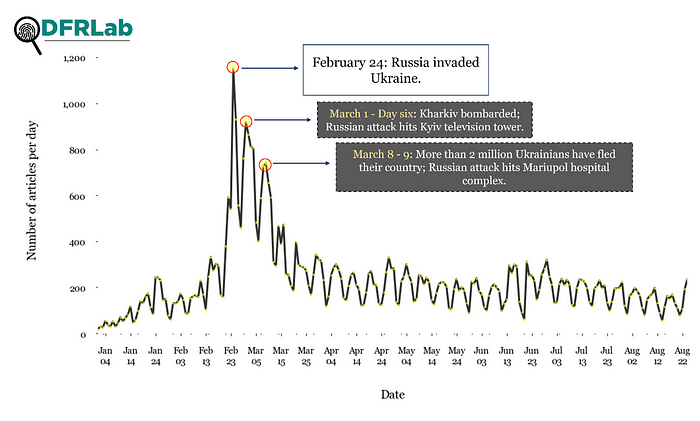
However, other spikes in content emerge when examining the publishing volume from only the Russian and Chinese state-backed outlets. For example, on March 29, RT en Español and Sputnik News highlighted talks between Russia and Ukraine in Turkey. That same day, these outlets also published narratives about neo-Nazis in Donetsk and content targeting US President Joe Biden. On May 30, another spike occurred when these outlets reported on Biden’s announcement that the US would not provide Ukraine with long-range rockets. Alongside this reporting, the outlets also amplified a Russian claim that casualties in Donetsk resulted from a Ukrainian armed forces strike.

Social distribution network
As noted earlier, the social distribution network of an outlet is the sum of follower counts from unique social media assets sharing the outlet’s content, such as Facebook pages or Twitter accounts. Our research tallied this measure by aggregating the number of followers from Facebook groups, profiles, pages, and Twitter accounts that shared at least one Ukraine-related news article from the analyzed Spanish-language media outlets. We collected follower counts for the social media assets sharing this content on both platforms using CrowdTangle and Twitter APIs.
To measure the social distribution network on Facebook, the DFRLab considered two main approaches: a social distribution network based on 10 percent of the published articles sorted by those with the most engagement, and a social distribution network based on the top 100 news articles in terms of the number of engagements. For Twitter, this measure included all the collected Ukraine-related articles per outlet.
The DFRLab found that CNN had the largest distribution network from the analyzed Spanish-language news sources, followed by El País and Infobae. Hypothetically, CNN’s distribution network can push content to over 600 million social media users, while content from RT en Español and Sputnik News could reach over 200 million users combined.

RT en Español appeared among the top five outlets with the largest distribution network. Based on the top 100 articles sorted by engagements, the Chinese state-backed outlet Xinhua ranked second among news sources with the most extensive distribution network on Facebook. More than 93 million of those users come directly from Xinhua’s Facebook page.
Although it is difficult to establish how many actual followers are reached when the outlets post content, according to 2020 research from We Are Social and Hootsuite, a Facebook post’s average organic reach is about 7 percent of a page’s total number of likes. By this measurement, and considering the overall social distribution network, CNN’s Ukraine-related content could have reached over 40 million social media users. In comparison, content from pro-Kremlin and Chinese state-backed outlets could have reached over 28 million users combined.
These accounts, however, are not de-duplicated across social media pages from the distribution network, meaning these figures may count the same accounts multiple times if they follow more than one asset sharing content from the analyzed outlets. Despite these caveats, the distribution network provides a useful comparison metric regarding estimated reach on Spanish social media for Ukraine-related content during the analysis period.
Engagement with Ukraine-related content
DFRLab analysis also measured the engagement of Ukraine-related content from the selected outlets, aggregating the number of replies, retweets, and favorites on Twitter. For Facebook, we considered the sum of comments, shares, and reactions, including likes and emoji responses. This analysis can provide an impression of how social media users engage with Ukraine-related content in Spanish-language countries.
Based on this measure, the DFRLab found that content published by Infobae and El País received more engagement than other media outlets. On Twitter, RT en Español was the third most engaged-with domain, while on Facebook, it ranked sixth among the analyzed news sources.
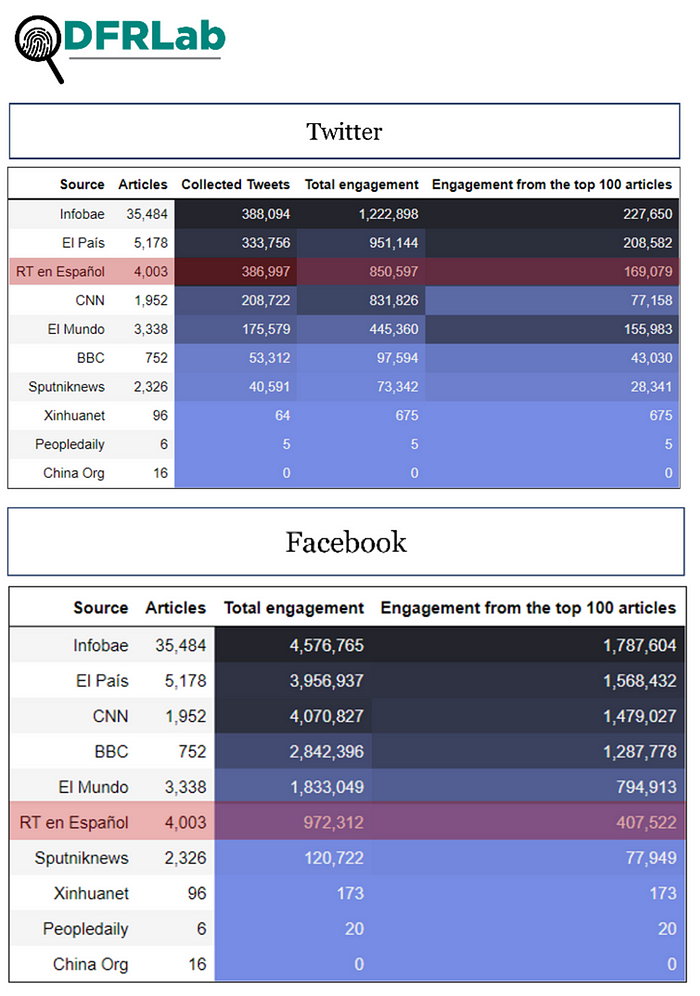
Given that Facebook restricted access to Russian state-backed outlets like RT en Español and Sputnik News in some regions, it is possible these restrictions impacted the outlets’ volume of engagement on the platform during the analyzed period. According to DFRLab analysis, RT en Español performed better on Twitter than on Facebook, whereas most of the studied outlets ranked similarly on both platforms.
To further explore Twitter activity, our analysis calculated the likelihood of traffic manipulation using the Coefficient of Traffic Manipulation (CTM). The DFRLab applied this measurement to study the Twitter activity of accounts sharing the news articles published by these media outlets.
CTM assigns a score to each Twitter traffic flow, such as the volume of tweets sharing news articles from a given media outlet, based on three indicators: the average number of tweets per user, the percentage of retweets, and the percentage of traffic generated by the fifty most active accounts. In earlier studies, organic, non-manipulated traffic flows typically scored a CTM of twelve or lower, while inorganic Twitter behavior resulted in scores higher than twelve. This measure, however, is only a relative indicator of manipulation, not a definitive one, and should be considered alongside other indicators.
According to the CTM results, all analyzed traffic flows scored above the threshold of twelve, ranging from 17.42 to 23.23. Accounts sharing content from RT en Español and Sputnik News had the highest CTM scores, followed by those sharing articles from CNN and BBC. On average, accounts sharing news articles from RT en Español generated more posts than other groups of accounts sharing content from the other analyzed news sources, which could indicate high link-sharing activity from these accounts.
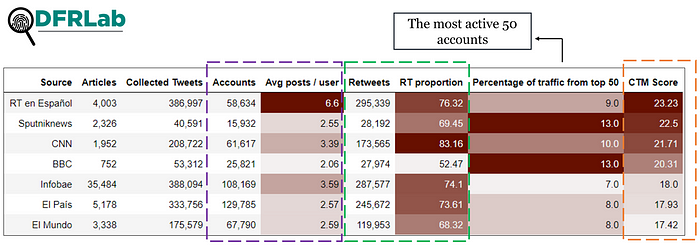
Measuring the social distribution network and levels of engagement for Ukraine-related content in Spanish over an eight-month period, including the first six months of the war, improves our understanding of how social media users have responded to this content on Twitter and Facebook. Russian state-backed outlets continue to target Latin American audiences with Kremlin-approved narratives. While Facebook’s restrictions on Russian state media led to lower engagement levels, Twitter continues to be a significant platform for these outlets, particularly RT en Español.
By Esteban Ponce de León, for @DFRLab
Esteban Ponce de León is a Research Associate, Latin America, with the Digital Forensic Research Lab.


